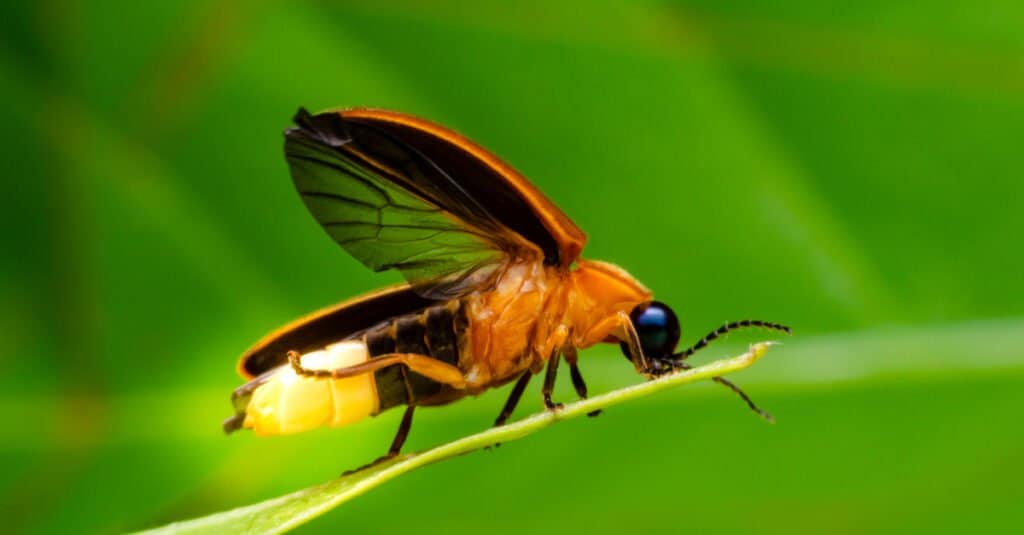Lightning bugs vs fireflies is a common debate among insect enthusiasts living in the south, north, or anywhere in the country these little night lanterns happen to show up. No matter what you call them, they look very similar to the seasonal lovebugs that decorate the front of your car’s bumper in springtime.
The truth is, regardless of where you live, lightning bugs and fireflies are one and the same. Like many species of insect, mammal, fish, or (insert animal here), they’re simply called something different based on geography and the cultural and social norms of the area.
The eastern and southeastern portions of the United States primarily use the term “lightning bug,” while the north and northwest stick with the term “firefly.” There are no other distinctions between the two outside of their dual names.
Why the Regional Differences?

firefly on leaf
©khlungcenter/Shutterstock.com
Believe it or not, many people, especially those riding the borders between what we consider north and south, use the two terms interchangeably. Lightning bug or firefly—it matters not. But those who embrace one term or the other do so for a reason and it’s more than just preference.
Another interesting regional preference is the West, where they call these particular bugs fireflies, rather than lightning bugs. Several publications make the claim that the term “firefly” may be indirectly influenced by the number of wildfires that break out in the West.
It’s not a genuinely scientific claim but, when there’s not much else to go on, it does make a kind of eerie sense. On the flip side, lightning bugs tend to correlate with areas that are more prone to lightning strikes, more so than anywhere else. Whether or not there is a true connection in the lightning bug vs fireflies debate is anyone’s guess.
This assumption (which isn’t bad by any means) comes from Dr. Jason Keeler, an Assistant Professor of Meteorology at Central Michigan University.
Lightning Bugs vs Fireflies

Lightning bug climbing a leaf.
©iStock.com/ErikAgar
Since they’re both the same bug, the true battle boils down to demographics and what certain regions call this glowing insect. Unfortunately, there is no numerical breakdown in terms of population percentages and what they call lightning bugs.
The best thing we have to go on is the above assumption from Dr. Jason Keeler. But, perhaps one day, someone will sit down and do an in-depth research poll and give us a more accurate measurement of how many people call them lightning bugs and how many people call them fireflies.
However, the lightning bugs vs fireflies debate don’t end there because that’s not the only name regions across the world apply to them.
- North American Southeast: Lightning Bugs
- North American Northeast: Lightning Bugs
- North American West: Fireflies
- North American Southwest: Fireflies
- North American West: Mix
- Italy: Lucciola
- Portugal: Pirilampos
- United Kingdom: Glow Worms
- Jamaica: Blinkie
- Brazil: Pirilampos
- Germany: Glühwürmchen
- Cuba: Cucubanos
- Japan: Hotaru
- Netherlands: Glimworm
The list gets even more extensive when you consider the fact that there is more than one name for lightning bugs or fireflies in North America. Depending on where you are or how you grew up, they also go by the names, glow fly, golden sparkler, moon bug, and fire devils.
Now, those names are far less common than lightning bugs vs fireflies, however, you may hear the terms from time to time, depending on where your travels take you.
What Are Lightning Bugs or Fireflies?

Close-up of the Pyractomena angulate firefly.
©Judy Gallagher / Flickr – License
Lightning bugs (or fireflies, depending on what your preference is) are actually beetles. Their scientific name is Photynis Pyralis, and they’re found all over the world. Some are even known for their synchronous light displays, such as the famous synchronous lightning bugs of the Smokey Mountains.
While synchronous displays are rare, scientists believe that it’s a defensive mechanism. It helps the females identify the males, rather than falling for a lure trap from a potential predator. Lightning bugs are only about 10mm to 15mm in length, feature a triple-segment body, and use bioluminescence to communicate.
They are usually red and black, with a reddish head and black wings that cover their yellow-like abdomens when not in flight. The yellow abdomen is where the bioluminescence occurs, through a combination of calcium, adenosine triphosphate, and luciferin.
They mostly prefer humid, warmer areas, though they show up all over the world, in nearly every type of climate. Lightning bugs are also omnivorous, and they feed on small snails or slugs in their larvae stage and switch to a plant diet once they reach their adult stage.
Final Thoughts on Lightning Bugs vs Fireflies
Regardless of what you prefer to call them, these beetles are one of the more interesting insects to share this world with us. Their bioluminescence capabilities are truly a sight to behold, especially when hundreds of them really get going, right around sunset each evening.
Though we may call them something different, depending on the region of the country we live in, they are fascinating nevertheless. Most people fondly remember evenings with mason jars and chasing lightning bugs—one of the best ways to create a childhood night light. Just be sure to poke some holes in the lid and release them in the morning!
The photo featured at the top of this post is © Fer Gregory/Shutterstock.com
Thank you for reading! Have some feedback for us? Contact the AZ Animals editorial team.






